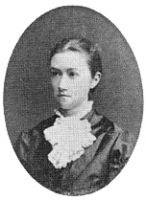Agnes Pockels
Quote: “Regarding your question about my personal circumstances I am really a lady.”
(From a letter of response to the famous English physicist Lord Rayleigh)
Why did I choose this woman?
Even though Agnes Pockels was in a situation where she didn’t have the chance to study the sciences, as she had to take care of her sick parents, she followed an admiring enthusiasm to gain new perceptions and find solutions to scientific problems. Thus she developed to become a scientific researcher by self-education, which is admiring.
During her daily dishwashing duties as a simple housewife she observed extraordinary phenomena in the dishwater. At the end of her life she received an honorary doctorate for her observations and results. However, until several years ago she was a forgotten scientist on whose research even a Nobel Prize winner based his results.
Family
Agnes was born in Venice as the daughter of an officer of the Austrian Army, stationed in northern Italy. The spread of malaria at that time weakened the health of the whole family Pockels. Her three years younger brother Fritz was still born in Vicenza. After that her father asked for an early retirement and in 1871 the family moved to Brunswick.
Agnes went to a public girls’ school at Brunswick, but it was impossible for a girl in the nineteenth century to attend a high school or a university. Furthermore, she was urgently needed to care of her sick family.
Fritz finished high school and started to study physics. Agnes developed an insatiable curiosity during her activities as a housewife.
Research
At the age of nineteen years during her daily dishwashing she discovered the variability of the surface tension of water on immersion of solids. She also watched filming on the surface of liquids.
And she thought that it could be possible to measure this film thickness and the surface tension of pure water. In her diary she wrote in 1891, “I have discovered the anomaly of the water surface.”
From simple means in her household Agnes developed a device in her kitchen, which later on in science was called ”Pockelscher Trog” (Pockels trough). A clean water surface could be produced with the device. Using a slider she could increase or decrease the water surface and thereby measure the exact surface tension of water.
Through her brother she had access to scientific literature in physics and therefore she could study by herself. Her observations with dishwashing water lead her to rigorous scientific research, but she did not get the slightest contact with relevant research institutions. As a woman she was not taken seriously.
Leonardo da Vinci and later Benjamin Franklin had already made corresponding observations. When a small quantity of oil was spilled on a pond, the water surface was smoothed. Unfortunately, exact measurements were not made.
By chance, Agnes read in a scientific journal edited in Brunswick, an article about the research results of the famous English scientist Lord John William Rayleigh, who succeeded in measuring the surface tension of oil contaminated water. Agnes wrote a long letter to the Lord describing her own research. Miraculously, she received an answer. Her letter in German language was translated into English by the wife of Lord Rayleigh. The English researcher was open-minded towards her and very interested in her observations and results.
The first contact developed into an intensive exchange of letters between Agnes and Lord Rayleigh. Through his recommendations, her work was published even under her own name in the renowned journal “Nature” on the 12 of March 1891.
Acknowledgments
About thirty years after her first scientific discovery, the scientific public got to know about a further development of the measurements of Agnes Pockels through Irving Langmuir. His research was based on the work of Agnes Pockels and later on in 1931 he was an elected Nobel Laureate. Thus today, the device to measure the surface tension of water is called the Langmuir scale in the technical literature. Only a few authors use the term Langmuir-Pockels-scale to measure the film on the water surface. These days, there should really be more acknowledgment to this dedicated and successful researcher Agnes Pockels.
On occasion of her 70th birthday in 1932, three years before she died, her hometown remembered the outstanding achievements of its citizen Agnes Pockels. She was awarded the honorary doctorate of the technical University Brunswick as the first and till now the only woman.
The Agnes-Pockels-Pupil Laboratory celebrated its tenth anniversary at the Technical University Brunswick last year. The Laboratory invites children and young pupils to do scientific experiments and is a reminiscent to the long road of equality.
References
- “Anniversary publication in occasion of the 150th birthday of Agnes Pockels”, “10th anniversary of Agnes-Pockels-Pupil-Laboratory”, Technical University Brunswick, 8th of March 2012
- “Data collection” Liane Biermann on behalf of the Press and Public Relations of the Technical Universitiy Brunswick
- “Agnes Pockels”, Klaus Beneke, Universität Kiel, July 2005
Links
- http://www.uni-kiel.de/anorg/lagaly/group/klausSchiver/pockels.pdf
- http://de.wikipedia.org/wiki/Agnes_Pockels
- https://www.tu-braunschweig.de/presse/veranstaltungen/kinderuni/pioniere/agnes-pockels/physik
- http://www.agnespockelslabor.de/en/agnes.html
Photo Source: Public Domain. http://commons.wikimedia.org/wiki/File:Agnes_Pockels.jpg




